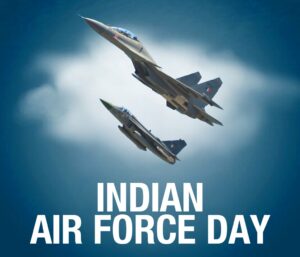Air war endurance, also known as sustainability in aerial warfare, refers to the ability of an air force or a nation’s air power to sustain prolonged operations and maintain a high level of combat effectiveness over an extended period.
Operational Tempo and Intensity. Tempo is the rate at which military power is applied in an efficient manner across part or the entire area of operations. The level of preparation required by the defence forces is determined by the combination of the expected duration of the war and the likely tempo/intensity of operations. Several key factors contribute to air war endurance and affect the duration, effectiveness, and efficiency of air campaigns.
Capability and Capacity Development
Capability vis-à-vis Capacity. Warfighting capabilities and the capacity to sustain operations are both essential.
Aircraft Type and Capability. The type of aircraft being used, their capabilities, payload capacity, and mission versatility significantly affect how effectively and efficiently air operations can be sustained.
Diverse Inventory. Indian military air assets have a very diverse inventory of platforms, systems, and weapons.
Logistics and Supply Chain Management. Efficient and reliable logistics networks and supply chains are crucial for providing fuel, ammunition, weapons, spare parts, other critical supplies, and resources to sustain aircraft operations.
Maintenance and Repair Capabilities. Efficient maintenance operations are essential to ensure the continued availability of air assets for extended periods.
Fuel Availability and Consumption. The energy supply chain is the first casualty in any war. Efficient fuel management plays a crucial role in prolonged air operations.
Training and Personnel Readiness. Intangible factors like morale, training and tactics are very important for military success and more so in long wars.
Protection of Air War Endurance Enablers. This aspect has pronounced relevance in long-drawn wars.
Decision Making & Situational Awareness. In long-drawn wars, it is even essential to make the right decisions. The three most important contributing factors are a high degree of situational awareness, a robust and fast, network system for information sharing, and AI-based decision support systems.
Unmanned Platforms. The use of unmanned platforms and systems is growing in warfare. Drones of various sizes and capabilities are taking over the tasks of conventional platforms.
Employment Philosophy and Airpower Application
Clearly Defined Objectives. A clear and practical definition of objectives, at all levels i.e. political, military and air force levels is very important.
Integrated Conceptualization and planning. Warfare has become multidomain in nature, and to optimise resource utilisation, integration of all capabilities is necessary at conceptual and strategic levels.
Strategic Planning, Adaptability and Flexibility. In long wars, strategic plans need to allow for adjustments and adaptability in response to changing circumstances or unexpected events during a prolonged air war.
Grey Zone Operations/No War No Peace Situations. Grey zone operations are operations in the contested arena somewhere between routine statecraft and open warfare. These are becoming a norm in modern-day warfare.
Airpower Application Strategy. Well-thought-out strategy would have to be employed for the application of Airpower. Relevant aspects would be as follows:-
-
-
- Effect-based operations.
-
-
-
- Selective dominance.
-
-
-
- Conservative risk-taking profile.
-
-
-
- Networked air environment.
-
-
-
- Precision and Stand-off capabilities.
-
-
-
- Sortie generation rate.
-
Larger Vital Aspects
Indigenous Defence Industry. Self-reliance is an absolute necessity in long-drawn wars.
Infrastructure. Adequate infrastructure is essential to increase the war endurance.
Resource Management and Sustainability. Long wars necessitate effective management of available resources, budget, and personnel to sustain a prolonged air campaign without running into shortages or burnout.
Economic Sanctions. The effect of the sanctions especially on air war, needs to be factored into the long-term plans.
Collective Security. Collaboration and sharing resources with allied nations or coalition partners can extend the endurance of air operations by pooling together expertise, assets, and capabilities.
Future Investments. Suggested future investments for the Indian Aerospace power are as follows:-
-
-
- Future Technology. Air Force is a technology-intensive service and converting technology into capability is a time-consuming process.
-
-
-
- Loyal Wing Man Concept. The thought process for the next generation of platforms is to harness the advantages of both.
-
-
-
- Hypersonic Weapons. The development of hypersonic weapons is likely to have a significant impact on air strategy.
- Hypersonic Weapons. The development of hypersonic weapons is likely to have a significant impact on air strategy.
-
-
-
- New Domains of Warfare. The domains like cyber, space, electronics and information have come into the influence of warfare. China’s formation of a Joint Strategic Support Force (JSSF) as a separate service, with defensive and offensive capabilities, in above mentioned four domains, indicates future challenges. Reorientation is required to deal with these changes.
-
-
-
- Space-Based Capabilities. Space-based systems are becoming increasingly important in air warfare, providing capabilities such as navigation, targeting, communication, early warning of missile launches and space-based surveillance.
-
Coming UP: Detailed article on the subject
Suggestions and value additions are most welcome
For regular updates, please register here
References and credits
To all the online sites and channels.
Disclaimer:
Information and data included in the blog are for educational & non-commercial purposes only and have been carefully adapted, excerpted, or edited from sources deemed reliable and accurate. All copyrighted material belongs to respective owners and is provided only for purposes of wider dissemination.

